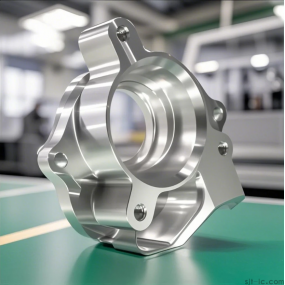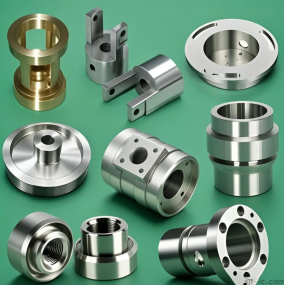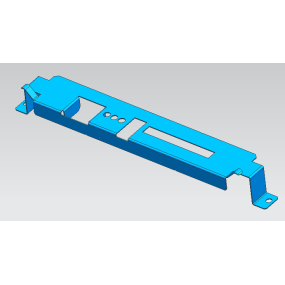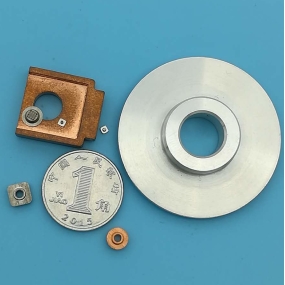1. Impact of natural climate
China has a vast territory, with most areas located in subtropical regions. The temperature varies greatly throughout the year, and the temperature difference within a day also varies. Therefore, people have different ways and degrees of intervention in indoor (such as workshop) temperature, and the temperature atmosphere around machine tools varies greatly. For example, the seasonal temperature variation range in the Yangtze River Delta region is about 45 ℃, and the diurnal temperature variation is about 5-12 ℃. The CNC Machining workshop generally does not have heating in winter and air conditioning in summer, but as long as the workshop has good ventilation, the temperature gradient in the CNC machining workshop does not change much. In the Northeast region, the seasonal temperature difference can reach 60 ℃, and the diurnal variation is about 8-15 ℃. The heating period is from late October to early April of the following year, and the design of the machining workshop has heating but insufficient air circulation. The temperature difference between inside and outside the workshop can reach 50 ℃. Therefore, the temperature gradient in the workshop during winter is very complex. When measuring, the outdoor temperature was 1.5 ℃ from 8:15-8:35 am, and the temperature inside the workshop changed by about 3.5 ℃. The machining accuracy of high-speed precision walking machines and precision machine tools will be greatly affected by environmental temperature in such workshops.
2. The impact of the surrounding environment
The surrounding environment of CNC machine tools refers to the thermal environment formed by various layouts within a close range of the machine tool. They include the following three aspects.
(1) Workshop microclimate: such as the distribution of temperature in the workshop (vertical and horizontal directions). When the day and night alternate or the climate and ventilation change, the temperature in the workshop will slowly change.
(2) Workshop heat sources, such as solar radiation, heating equipment, and high-power lighting, can directly affect the overall or partial temperature rise of the CNC machine tool for a long time when they are close to it. The heat generated by adjacent equipment during operation will affect the temperature rise of the machine tool through radiation or air flow.
(3) Heat dissipation: The foundation has a good heat dissipation effect, especially for precision CNC centering machine tools. The foundation should not be close to underground heating pipelines. Once it ruptures and leaks, it may become a difficult to find the cause of the heat source; An open workshop will be a great 'radiator', which is beneficial for temperature balance in the workshop.
(4) Constant temperature: The use of constant temperature facilities in the workshop is very effective in maintaining the accuracy and machining precision of precision centering machine tools, but it consumes a lot of energy.
3. Internal thermal influencing factors of machine tools
(1) Structural heat source for heart centered CNC machine tools. Electric motors such as spindle motors, feed servo motors, cooling and lubrication pump motors, and electrical control boxes can all generate heat. These situations are allowed for the motor itself, but they have significant adverse effects on components such as the spindle and ball screw, and measures should be taken to isolate them. When the input electrical energy drives the motor to operate, except for a small portion (about 20%) that is converted into motor thermal energy, most of it will be converted into kinetic energy by the motion mechanism, such as spindle rotation, worktable motion, etc; However, it is inevitable that a considerable portion of the heat generated during motion will be converted into frictional heat, such as bearings, guide rails, ball screws, and transmission boxes.
(2) Cutting heat during the manufacturing process. During the cutting process, a portion of the kinetic energy of the tool or workpiece is consumed as cutting work, while a considerable portion is converted into deformation energy of cutting and frictional heat between chips and the tool, resulting in heating of the tool, spindle, and workpiece, and a large amount of chip heat is conducted to the worktable fixtures and other components of the machine tool. They will directly affect the relative position between the tool and the workpiece.
(3) Cooling. Cooling is a reverse measure taken to address the temperature rise of the walking machine, such as cooling the electric motor, spindle components, and basic structural components. High end machine tools often equip the electrical control box with a refrigeration unit for forced cooling.
4. The influence of the structural form of machine tools on temperature rise
In the field of thermal deformation of CNC machine tools, discussing the structural form of longitudinal cutting CNC machine tools usually refers to issues such as structural form, mass distribution, material properties, and heat source distribution. The structural form affects the temperature distribution, heat conduction direction, thermal deformation direction, and matching of the machine tool.
(1) The structural form of CNC centering machine tools. In terms of overall structure, machine tools include vertical, horizontal, gantry, and cantilever types, which have significant differences in thermal response and stability. For example, the temperature rise of the spindle box of a lathe with gear shifting can reach up to 35 ℃, causing the spindle end to lift up, and the thermal equilibrium time takes about 2 hours. The inclined bed type precision turning and milling machining center has a stable base for the machine tool. The stiffness of the entire machine has been significantly improved, and the spindle is driven by a servo motor. The gear transmission part has been removed, and the temperature rise is generally less than 15 ℃.
(2) The impact of heat source distribution. On machine tools, it is commonly believed that the heat source refers to the electric motor. Such as spindle motors, feed motors, and hydraulic systems, they are actually incomplete. The heating of an electric motor is only the energy consumed by the armature impedance during load bearing, and a considerable portion of the energy is consumed by the frictional work of mechanisms such as bearings, screws, nuts, and guide rails. So the electric motor can be called a primary heat source, and the bearings, nuts, guide rails, and chips can be called secondary heat sources. Thermal deformation is the result of the combined influence of all these heat sources.
Temperature rise and deformation of a 5-axis CNC walking machine during Y-axis feed motion. When feeding in the Y direction, the worktable does not move, so it has little effect on the thermal deformation in the X direction. On the column, the further away from the Y-axis guide screw, the smaller the temperature rise.
The situation of the machine moving along the Z-axis further illustrates the influence of heat source distribution on thermal deformation. The Z-axis feed is further away from the X-axis, so the impact of thermal deformation is smaller. The closer the Z-axis motor nut is to the column, the greater the temperature rise and deformation.
(3) The impact of quality distribution. The influence of quality distribution on the thermal deformation of machine tools has three aspects. Firstly, it refers to the size and concentration of mass, usually referring to changing the heat capacity and heat transfer rate, and changing the time to reach thermal equilibrium; Secondly, by changing the arrangement of quality, such as the arrangement of various reinforcing plates, the thermal stiffness of the structure can be improved to reduce the influence of thermal deformation or maintain relatively small deformation under the same temperature rise; Thirdly, it refers to reducing the temperature rise of machine tool components by changing the form of quality arrangement, such as arranging heat dissipation ribs outside the structure.
(4) The influence of material properties: Different materials have different thermal performance parameters (specific heat, thermal conductivity, and coefficient of linear expansion), and under the same heat, their temperature rise and deformation are different.


 Spanish
Spanish Arabic
Arabic French
French Portuguese
Portuguese Belarusian
Belarusian Japanese
Japanese Russian
Russian Malay
Malay Icelandic
Icelandic Bulgarian
Bulgarian Azerbaijani
Azerbaijani Estonian
Estonian Irish
Irish Polish
Polish Persian
Persian Boolean
Boolean Danish
Danish German
German Filipino
Filipino Finnish
Finnish Korean
Korean Dutch
Dutch Galician
Galician Catalan
Catalan Czech
Czech Croatian
Croatian Latin
Latin Latvian
Latvian Romanian
Romanian Maltese
Maltese Macedonian
Macedonian Norwegian
Norwegian Swedish
Swedish Serbian
Serbian Slovak
Slovak Slovenian
Slovenian Swahili
Swahili Thai
Thai Turkish
Turkish Welsh
Welsh Urdu
Urdu Ukrainian
Ukrainian Greek
Greek Hungarian
Hungarian Italian
Italian Yiddish
Yiddish Indonesian
Indonesian Vietnamese
Vietnamese Haitian Creole
Haitian Creole Spanish Basque
Spanish Basque










